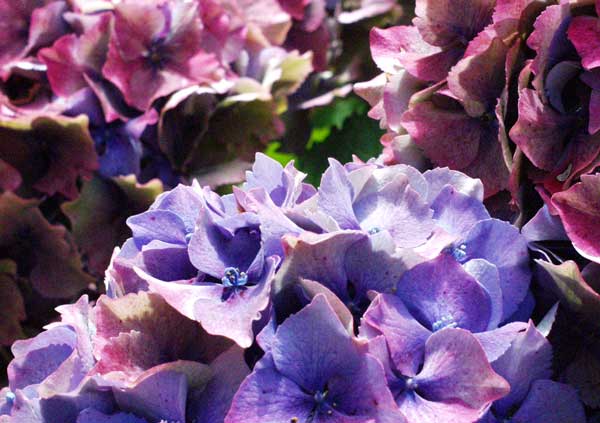It’s a beautiful, if windy, day today.
“The sun is shining.
The grass is ris.
I wonder where all the birdies is.”
That’s the poem my Grammy would say, with a twinkle in her bright blue eyes and a lilt in her voice, on a day like today. Then she’d listen for the birdies.
It’s something of a relief. After the beastly hot weather of Holy Week, and the cold snow of Easter (believe it or not), today was the first day it felt like real life outside. So I got to digging in my garden again. I planted my Easter hydrangeas. I got (for myself) 2 tiny little hydrangea plants for Easter decorations. They each had one bloom on them. I already have one hydrangea bush in my garden but it needs two more for my plan. So now these two will grow into their space. They look sort of sad and deranged out there right now. But some day they will look like this:

I also dug up the numerous dandylion plants that thought my garden plot was a nice place to rest. I don’t mind dandylions per se. But I don’t like them in garden. We have lots of them in our yard. I think the rest of the residents in our perfect lawn neighborhood curse us. But we don’t like the chemicals we have to use to remove them. You see, we live in the Chesapeake Bay Watershed and those chemicals go right into the bay, destroying the plant and animal life there and eventually into the ocean. That seems like an outlandish thing to do so that I can have a dandylion-free lawn. So we have lots of dandylions. Except for in my garden. I pull those.
The other cool thing about not using chemicals is that your dirt gets healthy. Did you know that dirt can be healthy or sick? I think that’s a fascinating concept. But I’m proud to say that I have healthy dirt. My foremost indicator is that I have a lot of worms. Worms love my garden. Which is ultimately good for the plants too. That’s the problem with chemicals as far as I can see. Once you begin using them, you have to continue because you’ve stripped away the ability of the dirt (soil) to maintain it’s own health. It can no longer support the vegetable life it was meant to. It doesn’t have the chemical compounds anymore, nor does it have the internal structures to fight off disease, pests and weeds on it’s own. It becomes sterile; merely an agent in which plants are grown, but everything else must be artificially added. However, if you do a little research and learn how to garden without chemicals, you can have healthy soil which will support vibrant plant life. Here’s the caveat though, you must be willing to accept more weeds than the gardener who uses chemicals. You must be willing to have a garden which is not picture perfect, but looks more natural; sort of fuzzy around the edges, but which attracts hummingbirds and butterflies, birds and perhaps deer.
As I was digging in the dirt and admiring the plentiful golden dots on my lawn, I thought about this. I thought about how this applies to the Church. For many people today the Church is sterile, it has become an agent where people are grown, maybe, but all Jesus-y agents must be added from without. They are learning to look good; as I quoted from Machiavelli yesterday:
“…that he may appear to him who sees and hears him altogether merciful, faithful, humane, upright, and religious. There is nothing more necessary to appear to have than this last quality, inasmuch as men judge generally more by the eye than by the hand,…”
But it is a sterile environment. And weeds are not tolerated. Oh, we’d love to attract some butterflies and hummingbirds on occasion, but they are so unstable and don’t really add anything to the bottom line, err, I mean, contribute to the ministry in a fashion that is acceptable.
 I wonder what might happen if we Jesus-followers decided to become natural gardeners? If we allowed our churches to become natural environments, and our soil to become healthy? What would happen if we allowed the weeds to pop up here and there. What if our gardens were specifically designed to attract certain types of life? What if we stopped building walls around our sterile perfect gardens and let in the weeds, the butterflies and the hummingbirds and created some healthy soil for ourselves and everyone else? Now that would be a garden!
I wonder what might happen if we Jesus-followers decided to become natural gardeners? If we allowed our churches to become natural environments, and our soil to become healthy? What would happen if we allowed the weeds to pop up here and there. What if our gardens were specifically designed to attract certain types of life? What if we stopped building walls around our sterile perfect gardens and let in the weeds, the butterflies and the hummingbirds and created some healthy soil for ourselves and everyone else? Now that would be a garden!